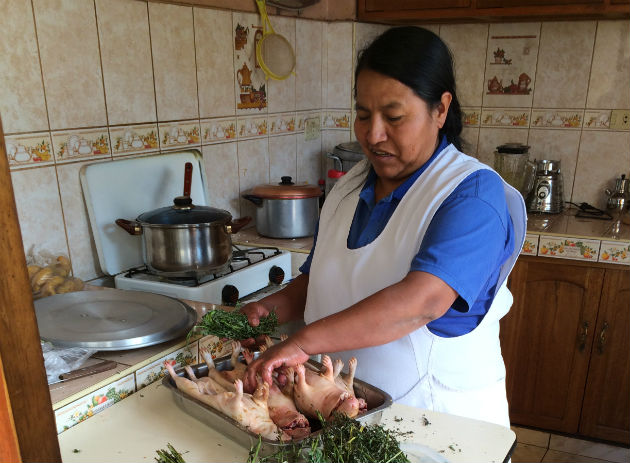Guess Who's Coming to Dinner?
It's Cuy!

Last year, my father went to Peru for research. He came back with a myriad of anecdotes, one of which really caught my attention: “We went into a small restaurant, which was almost a kitchen, and my cousin ordered a cuy. The lady, knife in hand, grabbed one of the small animals, of the dozens that roamed around the kitchen floor, put it on the table and proceeded to…”
I asked him to stop at that point. My father’s story gave me an uneasy feeling in my stomach, and it raised a lot of questions about the Peruvian diet and how it differs from the Venezuelan dishes I grew up with. I wondered, why was this story so repulsive to me? Why is it such a big deal that some people eat this little rodent?
As a master’s student at Florida International University, I decided to study Peruvian foodways—or the relationship between people and their food practices. While I dug into the histories of potatoes and quinoa, I was mesmerized by cuy and its importance across the Andean region.
The animal was domesticated in the Andean highlands between 3,500 and 2,500 BC. There are archaeological figures, pre-dating the Inka Empire, illustrating how important cuys were to past societies. Its importance has continued into present times, as they are now used as currency and in rituals, ceremonies, festivities, healing practices, and culinary traditions. In fact, its purpose as an exchanged good seems to be the root of its English name, “guinea pig,” referring to the English guinea coin.
In addition, various colonial paintings from the eighteenth century have shown the central role of guinea pigs in the Andes. For instance, Marco Zapata, a student of the renowned Cusco School of Art, created a representation of the Last Supper featuring cuy instead of bread. Imagine that, one of the most symbolic paintings in Christianity altered to highlight the guinea pig!
In the Andes, where the weather is quite cold, the warmest place to keep animals is near the stovetop or fireplace. Cuys can only survive in dark, warm places, so what better place than the kitchen? Though they are kept inside the home, Andean families do not perceive cuys as pets like they are in the United States. They are not named or given the attention of an animal companion but are accounted for by color and size. Since cuys can eat almost any vegetable, it is easy to throw them food scraps while cooking.
The cuy is not an everyday meal. It is eaten during special occasions, when important guests are visiting, and during celebrations like birthdays, weddings, or patron saint days. Sometimes it is thrown in stews, though the meat gets chewy when boiled. Most often it is roasted, fried, or cooked in a pit barbecue called pachamanca. Because of its small size and relatively small amount of meat, the cuy is prepared and eaten whole. Seeing a whole cooked cuy may seem strange to some, especially to Americans, but many of its “gross” parts are actually quite tasty.
In medicinal rituals, Andean community healers use cuys as a means to diagnose patients. The animal is rubbed over the sick person’s body and then examined. It is said that the cuy’s insides reflect the patient’s, thus indicating to the healer the reason for ailment. Within many Andean societies, cuys are also used to show appreciation. Many parents give children cuys as presents to signify a new stage in their lives.
Though cuy is widely consumed within the Andes and its migrant communities in other regions, it is also rejected by many in Peru. Since cuys cannot live in the hot, damp climate of the coast, people there are not accustomed to eating it. Reluctance to consume cuy in the United States is understandable since it is a domesticated pet. However, for those of you skeptics, I must argue that rabbits are also domesticated pets and that doesn’t stop high-end restaurants from serving them!
At the 2015 Folklife Festival, you can see how cuys are prepared by some Andean communities at El Fogón Kitchen, our foodways demonstration tent. Although it may seem strange to Americans, we hope you can appreciate this dish for its important culinary and cultural role in Peru.
Valentina Pilonieta-Vera is the program coordinator for the 2015 Smithsonian Folklife Festival’s Perú: Pachamama program.


